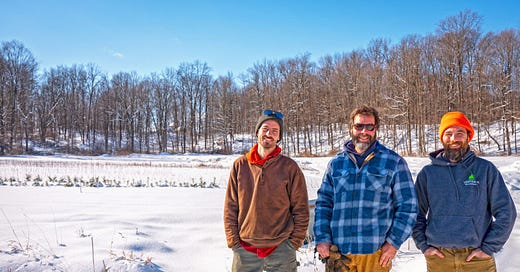Verterra Nursery is dedicated to selling and preserving native plants
By Chelsea Burton | Community News Service
For the trio behind Verterra Nursery, selling trees and shrubs native to Vermont is a way to help reinvigorate deteriorating ecosystems.
The conservation-focused nursery on the corner of Baldwin and Charlotte-Hinesburg roads has made a mission of restoring natural habitats through shoring up native plants. Flora native to Vermont are adapted to the state’s ecosystems, and their ability to thrive here helps the other species they’ve evolved alongside succeed, too. The team at Verterra has been working with a handful of agencies and nonprofits to grow and propagate those plants.
The company kicked off in 2023 when founders David Berg, Sam Gignoux and Nick Kierstead linked through Gignoux’s landscaping business, Imagine Land Care.

Gignoux had crossed paths with each – Kierstead, a tree removal specialist, and Berg, an expert gardener – and the three of them found a shared interest in countering invasive plants. With their combined backgrounds in agriculture and horticulture, they created a plan to do so by getting more native plants into people’s hands and yards.
“It’s important because the native plants are what support our whole ecosystem – they’re the food for the insects that then in turn feed the birds and other animals … They’re the base of our food chain,” said Berg, who studied environmental studies at the University of Vermont and won the Vermont Nursery and Landscape Association’s young professional award a few years ago.
Because they’ve evolved for many years, native species have developed intricate relationships and rely on each other. Native plants provide the preferred food source, habitat and host for native birds and pollinators, as well as prevent invasive species from moving in.
Foreign plants in the natural habitat can upset the native wildlife. “Non-native plants will spread and squeeze out native plants because there is no natural predator to combat the spread,” Kierstead said.
Buckthorn is one example of a popular foreign species that not only takes over the space for regional plants but also produces berries that are harmful to birds and other wildlife, he said.
The founders of Verterra said they want to see people grow native species along waterways because native plants are crucial to maintaining water quality. Compared to non-natives, plants that have evolved to grow along Vermont’s waters likely have root systems better suited to going deep into the soil and absorbing excess nutrients.
Invasive species throughout the watershed can lack the strong roots that prevent erosion during flood events. A lot of the plants Verterra produces end up on riverbanks; the company has worked with the Lewis Creek Association and the Addison County River Watch Collaborative, largely to mitigate flooding that has intensified over the last few years.
The trio started their nursery with the help of a grant from the Lake Champlain Basin Program to fund native tree nursery production. The program is federally funded and gives money to environmental organizations for opportunities that might otherwise be cost prohibitive.
“It was recommended we use our allocated Bipartisan Infrastructure Law dollars for this effort,” said Lauren Jenness, an environmental analyst for the basin program. “We supported seven total grants along with Verterra – five groups based in Vermont and two in New York.”
The organization’s focus on clean water, healthy ecosystems, an informed and involved public and thriving communities aligned with Verterra, she said.
So far, the nursery’s main clientele has been government agencies and nonprofits doing habitat restoration work. But the Verterra crew has plans to ramp up selling directly to people with their own gardens and landscapes. The nursery has two plant sales coming up: one April 26-27 and one May 3-4, both between 9 a.m. and 4 p.m. The trees and shrubs will cost around $10-20, depending on size.
People are often driven toward pristine landscapes and collecting plants that might be beautiful but may provide no support to the local wildlife, Berg said.
“We’ve lost connectivity in our natural landscapes because we’ve developed so much, and often in developed areas, what’s planted is not always native,” Berg said. “If people are putting even a little bit of habitat in their yards, you can redevelop the connectivity.”





